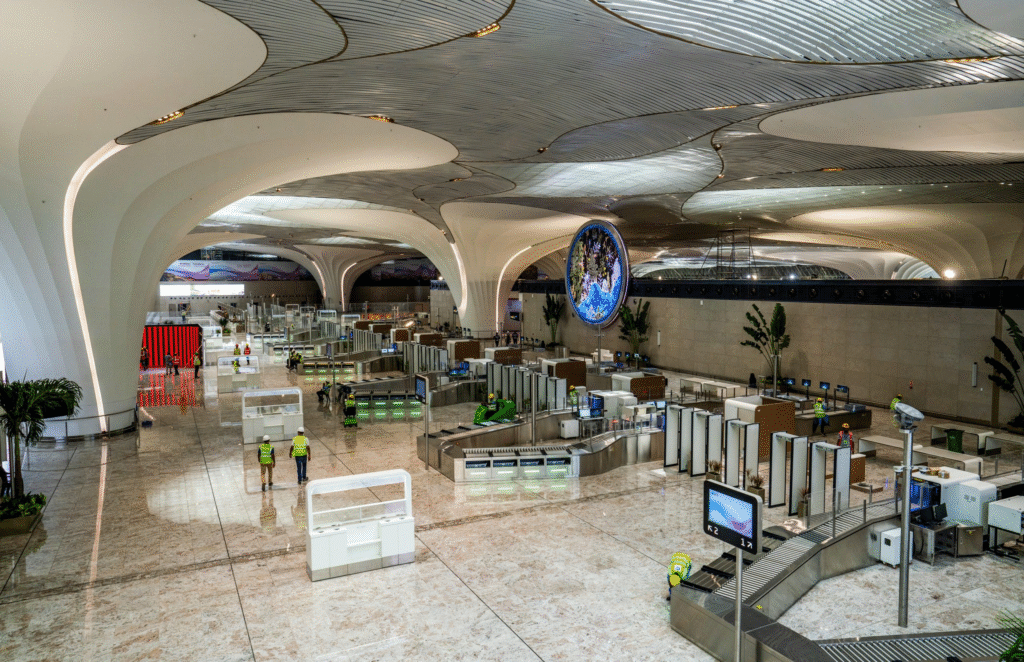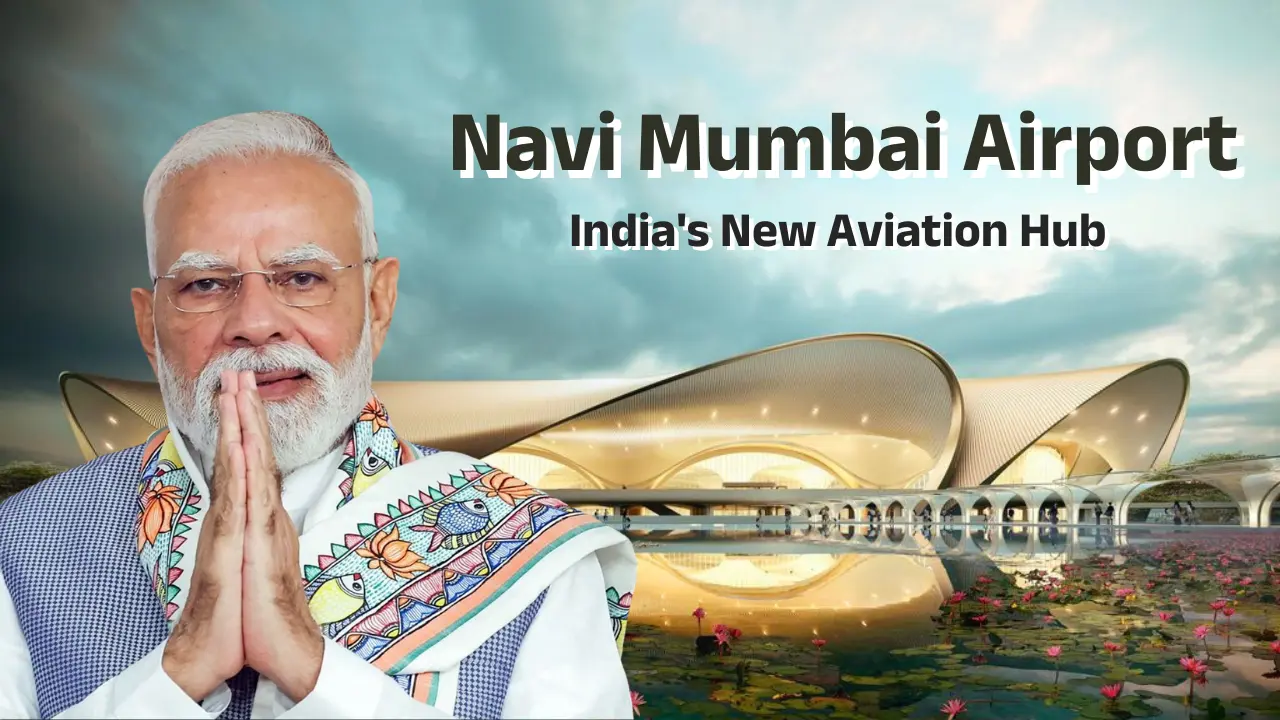PM Modi Inaugurates Navi Mumbai Airport: The city of Mumbai, India’s bustling financial capital, has long faced a seemingly insurmountable problem: severe congestion at its sole international airport, Chhatrapati Shivaji Maharaj International Airport (CSMIA). The long waits for landing and takeoff, the lack of slots for new airlines, and the pressure on logistics have made air travel in the Mumbai Metropolitan Region a challenging experience.
But that era of frustration has now officially ended. On October 8, 2025, Prime Minister Narendra Modi inaugurated Phase One of the monumental Navi Mumbai International Airport (NMIA) project. This event is far more than a simple ribbon-cutting ceremony; it represents a profound turning point in India’s aviation infrastructure and a massive boost to the economic potential of not just Mumbai, but the entire Western Ghats region, including Pune.

With an initial capacity of 20 million passengers annually, NMIA is set to drastically reduce pressure on the existing airport and firmly position Mumbai alongside global cities like London and New York that boast multiple international air gateways.
The Strategic Imperative: Why Navi Mumbai Needed an Airport
The demand for air travel in the Mumbai region has consistently outstripped the capacity of CSMIA. Confined by its location and surrounding urban development, the existing airport had reached its operational saturation point. The long-awaited solution was a greenfield airport on a massive scale, and that solution is the Navi Mumbai International Airport (NMIA).
The strategic importance of this new infrastructure cannot be overstated. It transforms the urban landscape and supports the government’s vision of a “Viksit Bharat” (Developed India) by building world-class infrastructure that enables rapid economic activity.
Project Scale and Cost
- Project Cost: The first phase of the project was constructed at an estimated cost of ₹19,650 crores (approximately $2.2 billion). This massive investment underscores the national significance of the airport.
- Total Area: The entire airport spans a vast 1,160 hectares.
- Ultimate Capacity: While Phase One starts with a capacity of 20 Million Passengers Per Annum (MPPA), the airport is designed for future expansion across multiple phases, aiming to eventually handle a colossal 90 MPPA and 3.25 million metric tonnes of cargo annually.
The inauguration by PM Modi signifies the successful completion of one of India’s largest Public-Private Partnership (PPP) infrastructure ventures, led by the Adani Group.
Advanced Features that Define the New Global Gateway

The Navi Mumbai International Airport is not just about size; it’s about smart, sustainable, and modern aviation. The design and technology deployed are a testament to India’s commitment to world-class infrastructure.
Architecture and Passenger Experience
The terminal architecture is a masterpiece of design, inspired by the national flower—the Lotus. This beautiful, culturally resonant design features a striking steel and glass roof supported by sculptural, petal-shaped columns, creating an open, naturally lit concourse that promises a calming and intuitive passenger experience.
Key features enhancing the passenger journey include:
- Automated People Mover (APM): An internal transit system designed to seamlessly connect all four planned passenger terminals, ensuring smooth and fast inter-terminal transfers.
- Contactless Processing: The airport is equipped for Digi Yatra integration, allowing for facial recognition-based, paperless processing for a swift and hassle-free journey.
- Extensive Check-in Infrastructure: Phase one includes a total of 88 check-in counters (66 staffed and 22 self-service stations) to keep queues minimal.
Focus on Cargo and Logistics
For exporters and businesses, the NMIA cargo terminal is a game-changer. The facility is equipped with a state-of-the-art, fully automated cargo terminal capable of handling diverse freight, including:
- Express deliveries and high-value goods.
- Dedicated, climate-controlled sections for medicines and perishable items.
As the Prime Minister highlighted in his address, this facility will “connect Maharashtra’s farmers to supermarkets in Europe and the Middle East, enabling fresh produce, fruits, vegetables, and fishery products to reach global markets swiftly.” This direct connectivity is a boon for local industries.
Impact and Benefits for the Mumbai-Pune Economic Corridor
The inauguration of the Navi Mumbai International Airport has far-reaching economic implications that extend well beyond the MMR. It directly impacts the industrial and IT powerhouse of Pune.
Boosting Regional Connectivity
The airport is set to significantly strengthen the entire Western Maharashtra region. The Minister of State for Civil Aviation emphasized that Pune, Pimpri-Chinchwad, and industrial belts like Chakan and Talegaon will gain “a golden opportunity to connect with the world.”
The connectivity is strengthened by existing and upcoming mega-projects:
- Mumbai Trans Harbour Link (MTHL): This new sea bridge drastically reduces the travel time from South Mumbai to Navi Mumbai, making the new airport highly accessible. The route from Pune to the airport via the MTHL is projected to take a significantly reduced time of approximately 2.5 to 3 hours, directly benefitting logistics and exports. (Internal Link: Related Post on MTHL’s Impact on Infrastructure)
- Multimodal Transport Hub: NMIA is poised to become India’s first airport with true multimodal links, integrating not only highways and metro lines but also suburban rail and the future potential for water taxi services.
India’s Aviation Growth Story
The NMIA inauguration aligns perfectly with a larger national trend. A telling statistic from official data reveals that India has expanded its airport network from just 74 in 2014 to over 160 today. This exponential growth, largely driven by the government’s UDAAN scheme, has made India the world’s third-largest domestic aviation market. The new airport reinforces this trajectory, pushing India to become a global Maintenance, Repair, and Overhaul (MRO) hub.
Looking Ahead: The Future of Air Travel in Western India
The moment PM Modi inaugurates Navi Mumbai Airport is a landmark in modern Indian history. It signifies a shift from a stressed, single-airport system to a modern, multi-airport metropolis that is future-proofed for the next few decades of economic and population growth. The NMIA is a key enabler for trade, tourism, and technological growth in the region.
Its commitment to sustainability, advanced technology, and expansive capacity makes it a powerful symbol of India’s infrastructural ambition on the world stage.
Conclusion: Take Off to a New Era
The official opening of the Navi Mumbai International Airport (NMIA) by Prime Minister Narendra Modi is a transformative moment. For travelers, it means reduced congestion and more flight options. For businesses, it means a streamlined, state-of-the-art logistics hub. This monumental project ensures that the economic engine of Mumbai-Pune will keep running at full throttle, soaring to new international heights.
FAQs
1. When did PM Modi inaugurate the Navi Mumbai Airport?
Prime Minister Narendra Modi inaugurated Phase One of the Navi Mumbai International Airport (NMIA) on October 8, 2025.
2. When will the Navi Mumbai Airport become operational for commercial flights?
While the airport was formally inaugurated in October 2025, it is expected to begin its commercial operations for both domestic and international flights in December 2025, following a period of extensive testing and regulatory clearances.
3. What is the initial passenger capacity of the new airport?
The first phase of the Navi Mumbai International Airport is designed to handle an annual capacity of 20 million passengers (MPPA). Its final, expanded capacity is projected to reach up to 90 MPPA.
4. How will the new Navi Mumbai Airport benefit Pune travelers and businesses?
The new airport will significantly ease international travel for Pune residents by offering more flight slots. Crucially, the advanced cargo terminal will boost exports for Pune’s major industries (like auto and pharma), with the Mumbai Trans Harbour Link (MTHL) cutting travel time to the airport to just 2.5 to 3 hours for logistics operators.
5. What is the total cost of the Navi Mumbai International Airport project?
Phase One of the NMIA project was built at an estimated cost of ₹19,650 crores (approximately $2.2 billion), making it one of India’s most significant recent infrastructure investments.

















